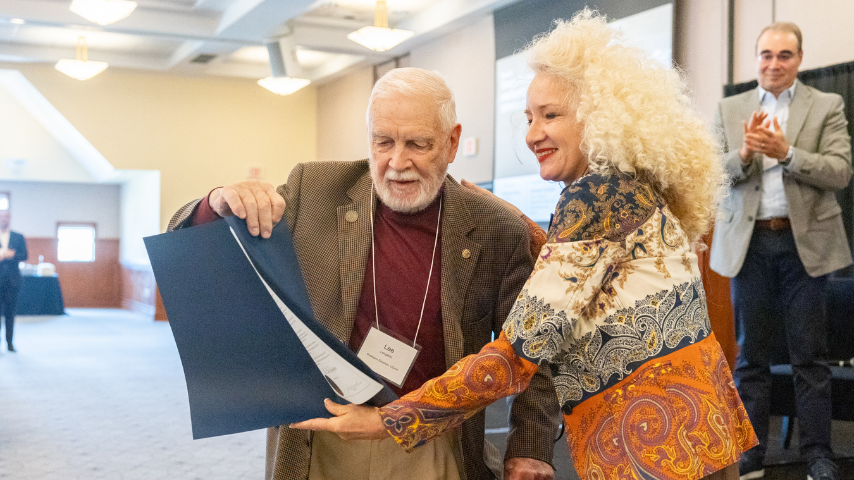ASME Life Fellow Received Connecticut Governor Commendation
ASME Life Fellow Received Connecticut Governor Commendation


Professor Emeritus Lee Langston, one of UConn’s most accomplished innovators, was presented a proclamation in honor of his outstanding contributions and enduring legacy by the school’s president.
University of Connecticut (UConn) Professor Emeritus Lee Langston was recently presented a proclamation to recognize his outstanding contributions and enduring legacy. “UConn Forum: Economic Engine of a Thriving Connecticut” brought together leaders, researchers, and public officials and it was there that Radenka Maric, the school’s president, presented the proclamation from the state’s governor.
Langston attended the forum without expectation of any recognition. Quoting author Erin Morgenstern, he said it was a much-appreciated surprise. “The finest of pleasures are always the unexpected ones,” he said. “I had no idea I was to be awarded a proclamation of my accomplishments from our very popular governor, Ned Lamont.”
An ASME Life Fellow, Langston received a BSME from UConn in 1959, and an MS in 1960 and a Ph.D. in 1964 from Stanford University. He was with Pratt & Whitney Aircraft in Connecticut as a research engineer working on fuel cells, heat pipes, and jet engines. Langston joined the UConn mechanical engineering faculty in 1977, becoming a full professor in 1983.
At UConn he taught graduate and undergraduate courses in heat transfer and fluid mechanics, with research activities involving the measurement, understanding, and prediction of secondary flow in gas turbines. He served as interim dean of the School of Engineering and became Professor Emeritus in 2003.
At ASME he has served as editor of the ASME Journal of Engineering for Gas Turbines and Power and has been a member of the Board of Directors of the ASME International Gas Turbine Institute (IGTI). In recent years, Langston has written a quarterly column and an annual review of the gas turbine industry for IGTI and Mechanical Engineering magazine and a technologue column for American Scientist.
Langston’s career included helping to develop the fuel cells that powered Apollo 11 to the moon. He also was part of a team that helped install the first solar panels at the White House. And Langston pioneered gas turbine technologies now used worldwide, including at UConn’s Cogeneration (CoGen) Central Utility Plant.
“[Langston’s] contributions to science and society are immeasurable,” Maric said in presenting the proclamation, adding that she first learned of his expertise in sustainable energy when she was studying for her Ph.D. Maric said the legacy of innovators such as Langston, along with the vision of people throughout the state, will be key to its future. “We make the impossible possible in Connecticut,” she said.
Langston commented, “In my youth, I knew and was influenced by Columbia’s Dean of Engineering, James Kip Finch.” The innovator died in 1967, but “in his book, The Story of Engineering, he wrote, ‘The engineer has been, and is, a maker of history,’” he explained. “During my now current 87 years, I’ve seen this to be true, with the results of worldwide engineering technology steadily and resolutely advancing.”
Cathy Cecere is membership content program manager.
Langston attended the forum without expectation of any recognition. Quoting author Erin Morgenstern, he said it was a much-appreciated surprise. “The finest of pleasures are always the unexpected ones,” he said. “I had no idea I was to be awarded a proclamation of my accomplishments from our very popular governor, Ned Lamont.”
An ASME Life Fellow, Langston received a BSME from UConn in 1959, and an MS in 1960 and a Ph.D. in 1964 from Stanford University. He was with Pratt & Whitney Aircraft in Connecticut as a research engineer working on fuel cells, heat pipes, and jet engines. Langston joined the UConn mechanical engineering faculty in 1977, becoming a full professor in 1983.
At UConn he taught graduate and undergraduate courses in heat transfer and fluid mechanics, with research activities involving the measurement, understanding, and prediction of secondary flow in gas turbines. He served as interim dean of the School of Engineering and became Professor Emeritus in 2003.
At ASME he has served as editor of the ASME Journal of Engineering for Gas Turbines and Power and has been a member of the Board of Directors of the ASME International Gas Turbine Institute (IGTI). In recent years, Langston has written a quarterly column and an annual review of the gas turbine industry for IGTI and Mechanical Engineering magazine and a technologue column for American Scientist.
Langston’s career included helping to develop the fuel cells that powered Apollo 11 to the moon. He also was part of a team that helped install the first solar panels at the White House. And Langston pioneered gas turbine technologies now used worldwide, including at UConn’s Cogeneration (CoGen) Central Utility Plant.
“[Langston’s] contributions to science and society are immeasurable,” Maric said in presenting the proclamation, adding that she first learned of his expertise in sustainable energy when she was studying for her Ph.D. Maric said the legacy of innovators such as Langston, along with the vision of people throughout the state, will be key to its future. “We make the impossible possible in Connecticut,” she said.
Langston commented, “In my youth, I knew and was influenced by Columbia’s Dean of Engineering, James Kip Finch.” The innovator died in 1967, but “in his book, The Story of Engineering, he wrote, ‘The engineer has been, and is, a maker of history,’” he explained. “During my now current 87 years, I’ve seen this to be true, with the results of worldwide engineering technology steadily and resolutely advancing.”
Cathy Cecere is membership content program manager.




